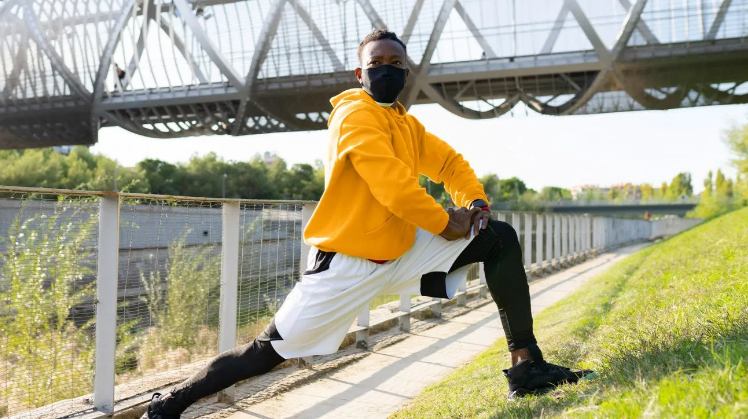- Researchers say cloth face masks can make exercising more difficult because they can affect breathing.
- Experts say you should focus on the length of your exercise routine rather than its intensity.
- They add that people exercising should still wear a mask for safety.
- They recommend choosing a face covering that fits well and is breathable.
If exercising just doesn’t feel the same since the pandemic started, it could be because of your cloth face mask.
That’s according to a new study published in the British Journal of Sports Medicine.
Researchers found wearing a cloth face mask while running vigorously on a treadmill was associated with a 14 percent decrease in exercise time and a 29 percent decrease in VO2 max, or the maximum amount of oxygen the body uses during exercise.
Participants self-reported feeling increasingly short of breath and claustrophobic at higher exercise intensities while wearing a cloth face mask.
The core recommendation from the study authors is that coaches, trainers, and athletes should consider modifying the frequency, intensity, time, and type of exercise when wearing a cloth face mask.
What experts have to say
You don’t need to exercise vigorously to reap health benefits.
“Exercising while engaging in rigorous physical activities compared to less intense exercise almost invariably can be more challenging,” said Vivek Cherian, an internal medicine physician affiliated with the University of Maryland Medical System.
“Rather than jumping straight to vigorous activities while wearing a mask, start slowly and gradually build up,” Cherian told Healthline. “The idea is this will give you a chance to gradually acclimate to more intense exercises.”
But don’t stop exercising, and don’t stop wearing a mask.
“Physical activity is one of the best ways to maintain physical and mental health, so we want to encourage people to find forms of exercise that are safe and comfortable,” said Dr. Eduardo Sanchez, MPH, FAAFP, the chief medical officer for prevention at the American Heart Association.
Strive for endurance over intensity
Cherian said that over time, as you get used to wearing a mask, you’ll naturally be able to increase your intensity.
For now, “shift your goal toward endurance (e.g., running a longer distance) rather than intensity (your speed),” he said.
“It’s also good practice to take slightly longer breaks between reps or sets than you normally would if you were not wearing a mask,” Cherian added.
Don’t stop wearing your mask
Wearing your cloth face mask helps prevent the spread of COVID-19.
“We’ve come this far, there is now light at the end of the tunnel. Now is not the time to stop with mitigation protocols including wearing masks in public,” Cherian said.
“The obvious risk is you are at a much higher risk of being exposed to and or spreading COVID without wearing a mask,” he added. “This risk is likely small if you’ve been vaccinated, but why take the chance?”
“At the rate the country is being vaccinated (millions on a daily basis), we perhaps are only a few months away from not being required to wear masks,” Cherian noted.
Comfort is key
“The bottom line is find the types of exercise you like and feel comfortable doing, and you’ll be more likely to stick with it and reap the benefits,” Sanchez said.
“I would recommend this Atoms mask for breathability during high-intensity workouts, and I find this Under Armour mask to be quite comfortable,” Cherian said.
Cherian’s face mask checklist
The right face mask will:
- be breathable
- fit well
- not get wet while you’re sweating and breathing hard during exercise
Regardless of which mask you choose to wear, the most important thing to keep in mind while exercising is to listen to your own body, said Cherian.
He offers the following advice.
Feeling unwell?
- Immediately stop your activity.
- Remove yourself from the crowd so you can safely remove your mask.
- Catch your breath.
Signs to stop exercising
- dizziness
- lightheadedness
- headache
- chest pain
- shortness of breath
- feeling as though you may pass out






